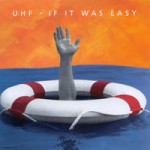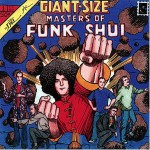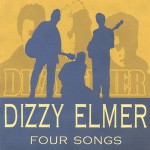 UHF
UHF
If It Was Easy
Second Story Records
It’s been a little over a year since we last heard from UHF, an engaging quartet headed by the talented brothers Leff, Jeremy, the lead singer, who occasionally contributes some keyboard and harmonica parts; Jordan, who guitar and keys- sharing the backup vocal duties with drummer Matt Johnson; while splitting the bass duties with second guitarist Jeff Nelson.
As was mentioned with last year’s Lottery, their first album, the band has a distinct ‘60s, British Invasion context, which is entirely anachronistic, considering the lads’ relatively young ages. At any particular time, the band sounds like the Who, the Beatles, the Kinks and Small Faces; as well as Badfinger, the Byrds, Pink Floyd, XTC, Split Enz, World Party, Eliott Smith and latter-day Tears For Fears. But this is no oldies band.
For, while the lads are not afraid to wear their influences on their sleeves- on this, their sophomore effort, those influences have been distilled into something nearer to a true style that is all their own. The four execute their well-wrought arrangements with laser-sharp precision. To help them
pull all of these elements, the band selected longtime scene-veteran Gregg Williams to produce the album. Gregg who has produced the Dandy Warhols among many others, lends a sympathetic ear and his fine technical abilities as a drummer to the proceedings, ably steering the band in a positive direction.
Leading off the album is “She Don’t Know. Chiming guitars sprightly drone behind Jeremy’s slightly detached vocal, somewhat reminiscent of E with the Eels. Jeremy’s wailing harmonica adds nice texture to the choruses. “Mr. Grey” sounds very Who-like (pre-Tommy), with Beatles undertones- Jeremy’s charming falsetto decorating the transitions between verseand chorus.
And electric twelve-string guitar lick drives “She’s Going Up,” placing it as Beatles, circa 1964-66, reminiscent of “I Call Your Name” and “Ticket To Ride.” It’s an uptempo tune, something XTC’s Colin Moulding might write. A hooky chorus and a satisfying bridge help to put this number over the top. A moody, descending chromatic electric piano figure colors “First Thing In The Morning,” with Jeremy’s voice sounding faint and adenoidal, like Eliott Smith, but emotive like Ed Roland of Collective Soul. as well. Nelson’s delicate guitar filigrees nicely decorate the song without being the least bit showy. His solo in the middle section is economical and succinct, making room for a brief bass interlude, before shifting down a gear for the extended fade.
Jeremy’s vocal on “Easy” could easily pass for Joey Molland of Badfinger, with a song arrangement extremely reminiscent of the Beatles. The chorus is directly related to McCartney’s “I’ll Follow The Sun” from Beatles ‘65/For Sale, the verse could be an early draft of “Drive My Car” from Yesterday & Today/Rubber Soul. A witty and clever lyric helps move the song along.
“Every penny that I’ve spent just left me for broke/My tickertape escape is just one more t-t-toke/It’s easy/Suddenly you’re gone in the blink of an eye/That’s just the kind of downer that gets me high/It’s so easy/So easy.” The chorus maintains the ascerbic attitude. “It’s easy, when you know who to know/It’s easy when you know where to go/It’s easy, when you know who to blow/Who to see/Who to be/Just follow me.” A seductive interlude in the middle featuring a young woman named Kitty performing the vocals over and Ted Camp of Ponticello on trumpet, add to the overall effect. A good song.
A lovely, Byrdsian melody graces “Toast,” a song that evolves in a different direction in the chorus/bridge. The bridge, especially, is somewhat ethereal. Another good song. “Moderntown” sounds like Tears For Fears, World Party or Tal Bachman doing the Beatles. Nice vocal harmonies and maniacal attention to sonic detail, with brilliant little touches and flourishes scattered throughout the presentation, adds immeasurably to the overall effect of the song. A watery organ plays against Johnson’s insistent snare on “Rain On The Street.” Nelson’s elegant slide guitar work, whirls lazily in the background, creating a drowsy liquid ambiance.
The songwriting and execution are at a consistently high level throughout this project. There are no pedestrian songs. There are no lukewarm performances. Every note on this album means something and was consciously placed into the mix. The production is as tight as it can be, without becoming sterile. UHF have made great strides toward presenting themselves in the best light– demonstrating musical chops, lyrical intelligence and subtle humor.
I have heard a lot of independent recordings in the past year, from all over the country. But not one has the polish and professional sheen that bands such as UHF, Jeff Trott, the Bella Fayes, and many other local bands exhibit. This is not civic pride talking necessarily, but what passes for journalistic objectivity. Such a statement is not easily explained. One suspects that the high level of musicianship which Portland bands have competitively sustained in the local clubs for the past twenty-five years has set the bar markedly higher than in most other cities: where the auteur aspect of the music business dictates that it uncool to be too good.
UHF produces diligently assiduous music, with top-notch proficiency, music that is accessible and entertaining. In any other industry but the one they are in, they would be obvious choices for a contract, with further career development. But in the Rock Music Industry, where talent is sometimes a liability and where marketability reigns supreme, one never knows.
 The High Violets
The High Violets
44 Down
Reverb Records
The High Violets’ second release finds the band continuing its exploration of the atmospheric realms first navigated by the Cocteau Twins. With the help of Clint Sargent’s thick, dense, highly-effected guitar work and Kaitlyn Ni Donovan’s dreamy, angelic vocals (Sargent also sings, about half the time, and Kaitlyn also adds guitar on all the songs), the band creates a swirling mass of gorgeous, ethereal musical sound.
Sargent has a knack for generating lush soundscapes on the guitar. Shimmering, echoing one and two-note glissades form indistinct musical panoramas in which organ and piano and myriad other instruments seem to be heard, like oases glittering in a sonic mirage. His voice is somewhat non-descript, a bit monotonal, but pleasant. And it blends with Kaitlyn’s voice in a very British sort of way.
The High Violets music is more linear than are Kaitlyn’s solo compositions (and albums). The band setting affords her the opportunity to delve into a format and setting different from (but attuned with) her own. The result is uneven: sometimes exquisite (as with the title track and “Fa”) and other times only merely very good. Bassist Allen Davis and drummer Luke Strahota prove themselves to be able contributors to the rhythmic and tonal foundation of the band.
A drumloop inaugurates “44 Down,” as Clint’s gesticulating guitar, abetted by Kaitlyn’s electric rhythm guitar, sets the mood. Quickly, Strahota and Davis kick in, providing an exponential increase in intensity. Kaitlyn enters with doubled vocals, singing divinely, sweet, heavenly harmonies. Like the best of Lush. Very pretty. Sargent’s skittering echoed guitar generates its own choirs on “Fa,” as Kaitlyn sings octave-separated vocals. A transcendent flute sound (probably coming from Clint guitar) whirls ineffably around the periphery of the scene, like a ghost, sighing sonorously to the end.
More distinct is Clint’s elusive backwards-like guitar intro to “Colors,” which unfolds into a twin vocal between Kait and Clint. An apparent guitar synth helps Sargent conjure high, organ-like tones on “Julia,” a more straightforward arrangement, makes this number a bit motre memorable among the songs Clint sings. His meditative vocals hypnotically transfer information that is mixed just below the level of clear audibility, transmitting directly to the sub-consious.
Nervous organ/string like sounds murmur beneath “Sparkle,” as Clint and Kait whisper their vocals. Sargent cuts loose with a fiery solo. Distinct organ-like sounds accompany the guitars on the waltzing “Dream Away.” Clint and possibly Kaitlyn form a celestial chorus for the vaporous vocal tracks. Clint again cuts loose with a molten solo the rivets the song into place. “Wheel” is nicely laid out, with Clint presenting the vocals in the verses, while he and Kaitlyn share the vocals in the chorus. Dark and ominous.
The High Violets have their own sound, influenced by bands as diverse as the Jesus and Mary Chain to U2 . Though they have yet to fully integrate the two lead-singers into the sonic picture, their are still a variety of vocal textures to be found. And though Clint Sargent has yet to rein in his sometimes amorphous guitar tones, he is never less than stupendously inventive, fashioning rich orchestral layers over which the songs develop and transpire. The band’s sound is haunting and galactic. Very interesting indeed.
 Funk Shui
Funk Shui
Giant Size-Masters Of…
Burnside Distribution
Funk Shui is comprised of several members of the dear-departed Tree Frogs, but, like the Tree Frogs, they are stylistically all over the place. The former Tree Frog rhythm section of drummer Jeff Duffy and bassist Sean Norton (who along with singer/guitarist John Henry Bourke, were the founding members of Funk Shui, when they first began as the house jam band at “Monday Night Funk at Biddy McGraw’s” ) hold down the funk end of things. The addition of guitarist David Murphy (formerly of Government Bird) and the exciting horn section of former Tree Frog saxman Rob Matthews and longtime local trumpeteer, Robbo Gilfeather (with whom I just may have played: at a gypsy funeral, a long, long time ago) add immeasurably to the general Funk., Soul and R&B atmosphere. Together, the two Robs, are a tour du horn, at times echoing the Chicago horn section or the Tower Of Power horns.
There are three songwriters in the band, Bourke, Norton and Murphy. While this adds a lot of variety to the presentation, it also adds a schizophrenic quality to the material. Bourke’s contributions alone vary dramatically. One song might sound like Stevie Wonder, the next Marshall Tucker. Norton’s songs tend toward the off-kilter, with Sean’s strange voice calling to mind Tom Waits’ gruff delivery. Meanwhile Murphy, who constructs fairly straight-ahead Funk confections and plays great guitar, can’t sing a lick. He could get closer to a pitch with a bat than he can with his voice.
Not unlike Jamiroquai or Simply Red, Bourke’s “Freestyle,” probably the winning tune of the nine-song set, has a strong sense of Soul. John Henry’s vocal is warm and soulful as well. Murphy’s guitar interplay with the horn section is red-hot. Norton’s “Lockjaw” is closer to the sort of Blues number that Dr. Hook and the Medicine Show might have performed way back when.
“60/80,” an instrumental by Murphy, has things in common with Edgar Winter’s “Frankenstein” and serves as a great vehicle to show what the different soloists in the band can do. Quite a bit apparently. “Sammich” is a fun song that ponders the invention of the sandwich, throwing a little country two-step in the middle, with Sean’s scintillating Funk bass solo standing out as a classic moment. Twisted.
Bourke’s “Shakedown” sounds sort of like Kenny Loggins or Mickey Thomas (of Marshall Tucker and latter-day Jefferson Starship) fronting the Doobie Brothers. Some nice horn charts dispel that comparison to a certain extent. Murphy’s irreverent “Pocket Rocket” shows a good sense of humor, recalling the classic Minneapolis white-boy funk band of the ‘80s, the Wallets. Whatever happened to the Wallets? Especially impressive is Gilfeather’s sonorous trumpet solo in the middle section.
Bearing a fleeting resemblance to Van Morrison’s “Tupelo Honey,” Bourke’s “Backseat Driver” could easily pass for a Tree Frogs song, not that that’s a bad thing, necessarily. John Henry belts out a soulful vocal performance on this number. Murphy’s “”Visa Denied” is heavy with the Funk. But his vocal is so off-pitch, one cannot even refer to it as Jazz. Whew! Not otherwise a bad song. Finally, the frenetic Funk of Norton’s “She Rocks” is a fine showcase for Norton’s superb basslines, Murphy’s guitar playing is spot-on and the horns lay out a discordant spread worth of the Flock from the early ‘70s.
Fans of the Treefrogs will love Funk Shui. This incarnation of the band is far tighter than its predecessor. With the recycling of the ‘70s funk movement now upon us, it would seem that Funk Shui are properly positioned to ride the wave of the revival. A fun band, with good dance grooves.
 Dizzy Elmer
Dizzy Elmer
Four Songs
Self-Produced
The trio Dizzy Elmer have been in the local scene for a few years now purveying their high energy New Wave/Punk musings, with unabashed vigor and elan– and a sizable slice of sharp musical precision. Guitarist Jethro Grady has a voice reminiscent of Elvis Costello or John Hiatt: a tad gruff and gravelly, but supple and elastic at the same time. Drummer Skeeter Joplin, delivers a tight, punchy beat without a lot of excess or ornamentation. Bassist Spud Lee Murphy adds solid backup vocals to the mix, helping to create a sort of B-52s like aura on a couple of the songs.
“Rosalyn” kicks off the four-song set, an uber-tempo, upstroke affair with hairpin turns and lightening fast straightaways. Grady and Murphy blend well. lending a wry sense of humor to their interpretation of the lyrics. Grady’s blistering guitar solo is spot on, as well. Catchy. Combining a low-string guitar motif that calls to mind George Harrison’s “Don’t Bother Me” with a Richard Thompson-ish vocal stance, singing a ‘60s-type Neil Diamond ballad, along the lines of “Solitary Man,” while melodically paraphrasing a piece of the intro to Elton John’s “Goodbye Yellow Brick Road.” Pretty cool.
The chord sequence to “Once Upon A Time” could be taken from any five early Kinks songs, especially “Tired Of Waiting” and “See My Friends”, while melodically mirroring somewhat Kurt Cobain in Nirvana’s “Smells Like Teen Spirit,” an appropriate combination, to be sure. Murphy’s vocal contribution in the catchy chorus lends the tune a poppy, Human League-like flavor. Grady uncorks a ripping solo in the middle section here, displaying a veritable arsenal of R&R guitar weaponry.
Another uptempo number, “I Think I Danced” is a humorous “morning after, the night before” sort of scenario, with minor-key, upstoke verses and straight-ahead rock choruses. Another flashy solo by Grady belies his indie, outsider stance. The guy can flat out play.
Dizzy Elmer are a fun band, with chops aplenty and the sort of rootsy aplomb generally reserved for top-flight cover bands. However, this band has underground credentials, with Murphy highly regarded as a comic book artist. While their material is far from original, the delivery of that material is both sincere and exact, making of them an extremely entertaining group.
 No. 3 Breakdown
No. 3 Breakdown
The Plastic EP
Self-Produced
Singer/songwriter Tommy Harrington has a vocal style comparable to Perry Farrell, a raspy tenor– bastard sons of Rod Stewart. Harrington’s compositions and guitarwork call to mind Collective Soul and the Goo Goo Dolls. With only a drummer for additional accompaniment to his lone guitar, Harrington amasses a quixotic sound, similar in some ways to that of Rebecca Gates and Spinanes: raw music, stripped down to the bare essentials.
A jangly angular guitar riff initiates “You’re On Blue,” before giving way to a more conventional plan of attack , with antecedents in the Ramones. The mysterious line, ”Who knows you’re on blue/When every bruise looks good on you,” flirts petulantly through the chorus, before the song begins to out for the second half of the song. Oddly catchy.
Possibly autobiographical, “Wonderful Mess” details the story of a person reaching the end of his rope. “I was trapped and wrapped up in a scene that was never really me/Plastic lies and sorry eyes and all the freaks were left outside.” Harrington’s hoarse delivery lends emotional impact to the tune. An attractively rough chorus helps to drive the song home. A bit of madness toward the end of the song fails to further the forward progress of the song, bordering on a rant.
A buoyant ascending acoustic guitar line motivates “Radiant, before rolling into the roiling the second verse with the thundering rumble of a herd of electric guitars. The rest of the song unfolds in a similar fashion, alternating between the light and the heavy, repeating a sing-song melody.
Tommy Harrington and No. 3 Breakdown show some promise, although, as a songwriter, Tommy seems to occasionally lose his focus. All three songs presented here have strong melodic hooks, though at times they lack the substance to sustain repeated auditions. One wishes that Harrington would work a little harder to give his compositions a sense of completeness. Some of the songs are mere fragments, Still, Harrington shows promise. And it will be interesting to see where No. 3 Breakdown goes from here.
